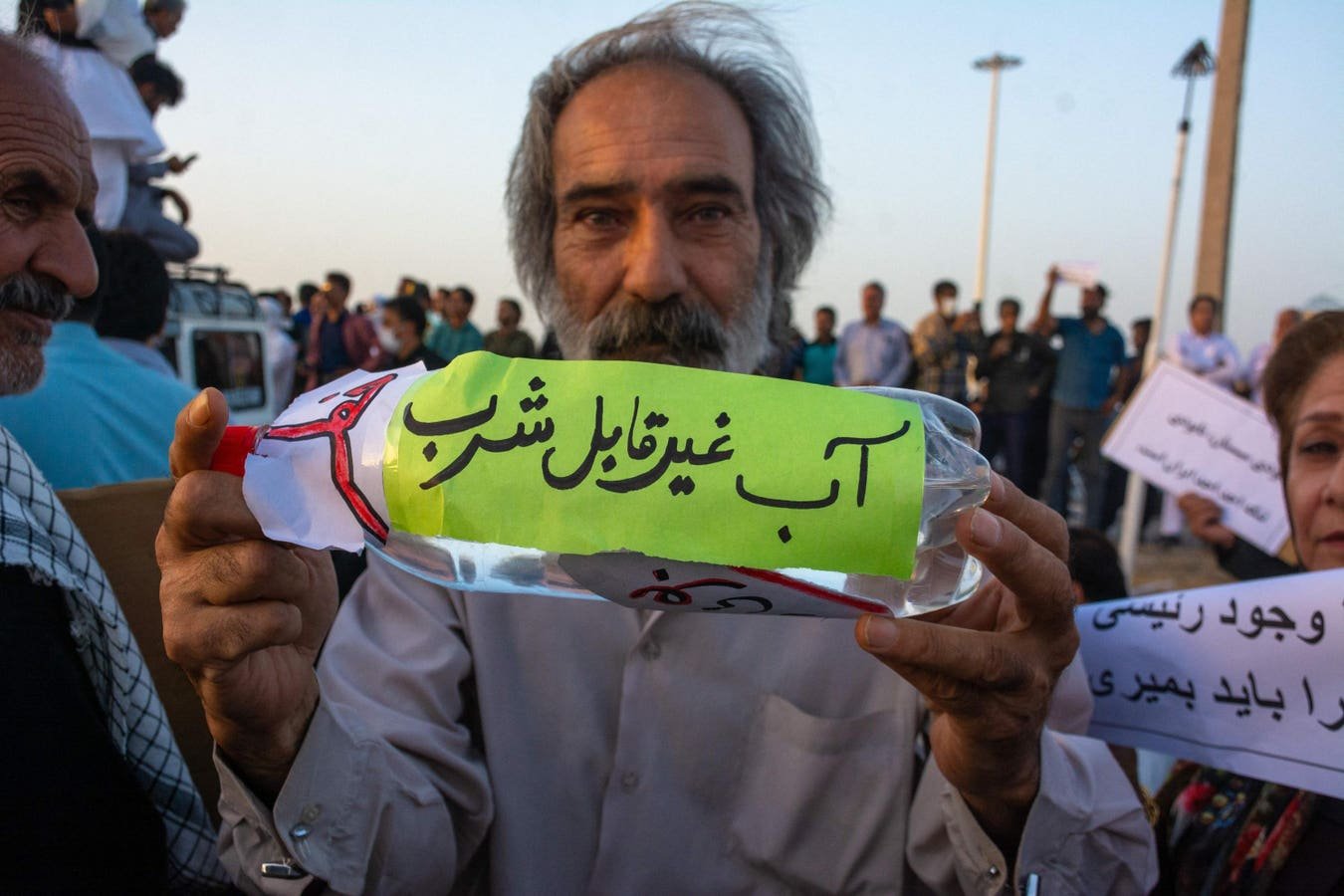An Iranian man is seen protesting, holding a sign that reads “undrinkable water.” The image was … More taken in a province in southeast Iran in July 2023 during disputes over water shares and drought. (Photo by HOSSEIN/Middle East Images/AFP via Getty Images).
A province in central Iran has become the latest battleground as farmers voice their frustration over severe water shortages, which are mostly caused by poor management and made worse by climate change.
Last month, tensions rose in Isfahan over water from Zayandeh Rud, a vital river that runs through the city and supports drought-stricken farms in the region.
For weeks, rural communities in eastern Isfahan have protested water being transferred to the nearby city of Yazd, claiming the water belongs to them. In late March, things got worse when local media reported that unidentified individuals had set fire to a pipeline carrying water from Isfahan to Yazd, damaging and sabotaging its infrastructure.
Following the attacks, officials in Yazd—a big province that gets half of its drinking water from the pipeline— announced the closure of schools and government offices for two days. Emergency tankers were also brought to provide water to thousands of people whose daily lives were impacted by the loss of supplies.
Meanwhile, experts believe the incident in Isfahan is a reaction to decades of mismanagement of water resources by the Islamic Republic, which prioritizes economic gains over the health of its citizens and the environment.
Case in point- central Iran hosts some of the country’s most lucrative steel plants, which consume vast amounts of water resources in an area that is considered inherently dry.
Ali Nazemi, an associate professor of building, civil, and environmental engineering at Concordia University in Montreal, says when it comes to water allocation decisions, there is a widespread perception that authorities favor regions that support industrialization over traditional ones.
Therefore, “Yazd, with limited surface water but considerable political influence, is viewed as a beneficiary of a flawed and unfair governance structure,” adds Nazemi.
For Isfahani farmers, “the pipeline represents the physical embodiment of an unjust system that takes their livelihood from them and gives to others,” he adds.
Iranians gathered during a protest to voice their anger after their province’s lifeblood river dried … More up due to mismanagement and drought in the central city of Isfahan in November 2021. (Photo by Fatmeh Nasr / ISNA / AFP) (Photo by FATMEH NASR/ISNA/AFP via Getty Images).
Déjà Vu
This is not the first time something like this has happened, though.
Back in July 2021, severe water shortages in the southwestern province of Khuzestan triggered protests that quickly spread to the entire nation. According to human rights organizations, dozens were killed, and many more were injured as security forces used live ammunition and violence to suppress the crowds.
Just a few months later, thousands of protestors in Isfahan, including farmers, gathered on the dried-up bed of Zayandeh Rud, demanding its water be restored.
Fast-forward to today, and the grievances remain unresolved. Experts say this is because no fundamental change has been made to the root causes of Iran’s water crisis.
Over-extraction of groundwater, unsustainable development, and unchecked population growth are just a few examples.
Mohsen Mesgaran, an assistant professor of plant sciences at UC Davis in California, says whenever unrest or conflict over water takes place, the immediate response (by the authorities) has typically been to transfer more water by constructing additional tunnels or importing desalinated water.
“There have been few, if any, efforts to reduce water use, decrease development’s reliance on water, minimize waste, or recycle water,” adds Mesgaran.
For people living in Isfahan, witnessing the city fall into turmoil is a familiar but troubling experience. A 57-year-old university faculty member, who asked to remain anonymous for fear of official reprisal, says the ongoing depletion of Zayandeh Rud River will likely cause more instability in the region.
Especially in the summer when heatwaves and electricity cuts are almost sure to increase the demand for water. “We may see a repeat of the large protests which occurred in Isfahan a couple of years ago,” he adds.
A view of a historical bridge (Si-O-Se-Pol) on the dried-up Zayandeh Rud River in the central city … More of Isfahan in December 2021. The river has dried due to mismanagement and drought and is a lifeline to the farming community. (Photo by Morteza Nikoubazl/NurPhoto via Getty Images).
‘Water Wars’
One major issue is the Islamic Republic’s overemphasis on self-sufficiency in agriculture, a sector that extracts more than 90% of the country’s water resources and uses unmodern and wasteful methods like surface and flood irrigation for watering crops.
For example, in central Iran, where water is scarce, local farmers grow crops like watermelon and rice because they sell well, even though they use a lot of water.
Mesgaran says economic development in these regions has not been based on environmental capacity or available water resources but rather has relied on limited water borrowed from other basins across the country.
“Over time, the livelihoods of people—particularly farmers—have become closely tied to this borrowed, unsustainable water,” he adds.
Nazemi says in this situation, rural communities, already stressed, will most probably face even tighter groundwater restrictions and supply cuts.
“Less water will be available just as more people and sectors demand it — a classic recipe for a broader resource conflict,” Nazemi says.
“We may soon see militarization of water infrastructure and unilateral provincial actions to capture or protect water resources,” he adds.
